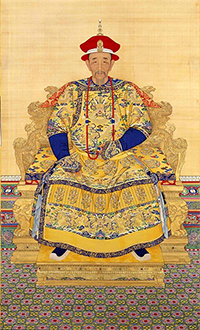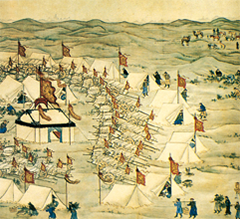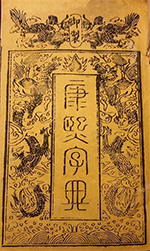China's Kangxi Emperor
The Kangxi Emperor was the third of China's Qing Dynasty rulers and, in his 61 years of rule, presided over a time of increased prestige and prosperity. He was on the throne from 1661 to 1722. 
A warlord named Nurhaci had united a number of Manchu tribes and, in 1616, declared the Later Jin dynasty. His son and successor, Hong Taiji, was the first to declare a brand new dynasty, the Qing, in 1636, with its capital at Mukden. He took full advantage of the chaos that enveloped the last Ming Dynasy emperor and paved the way for the first Qing emperor to rule from Beijing, his son Fulin. The successor was just 5 and depended on two uncles to act as regents. Officials proclaimed Fulin the Shunzi Emperor. The boy ruler waited seven years to declare himself free of regency. His personal rule lasted a decade, during which his armies strove to complete the conquest of the remaining Ming rebels. He died of smallpox in 1661, when he was 22. It was like father, like son, as succeeding the Shunzi Emperor was his 7-year-old son, Xuanye (who had survived smallpox), who became the Hongxi Emperor. 
That emperor ruled for 61 years, achieving the longest-ever imperial reign in Chinese history. For eight years, he depended on four regents and his grandmother, the Grand Empress Dowager. He then declared personal rule and set about enhancing his empire's growth and prestige. Personally, the Kangxi Emperor was hardworking and revered learning. He studied math, science, and geography, among other subjects, in order to understand more of the world around him. He took a great interest in the day-to-day workings of his government, empire, and armies, including in one instance leading his troops into battle. Not all of the emperor's subjects agreed with his policies. The Qing rulers had come to power through means of military conquest, and supporters of the preceding Ming Dynasty were still prevalent in various parts of the empire. In an attempt to assert his authority firmly, the emperor ordered three powerful officials to leave their hereditary domains and go into retirement up north, in Manchuria. The response was the Revolt of the Three Feudatories, perpetuated by Geng Jimao of Fujian, Shang Kexi of Guangdong, and Wu Sangui of Yunnan. They put together a large army to resist relocation, and it took imperial forces eight long years to put down the revolt. Two years later, the Kangxi Emperor enjoyed a naval rout of Ming loyalists on Taiwan. The result was a Qing takeover of the island. 
In the north, Qing forces fought against enemy forces in Mongolia and Russia. The conflict against the latter ended in 1689 with the Treaty of Nerchinsk, China's first with a European power. Against the former, Qing forces deployed a combination of diplomacy, intervention, and war, all resulting in an even greater Chinese presence there. Despite all of that armed conflict, much of China enjoyed a relative peace, allowing the Kangxi Emperor's economic policies to take hold. A reduction in taxes found favor with everyone, and slightly increased interactions with other civilizations filled Chinese coffers. (In fact, the emperor left behind a large surplus.) Like many emperors of many previous dynasties, Qing rulers employed an efficient bureaucracy to oil the machinery of government and trade. The Kangxi Emperor achieved this by championing the Confucian values that traditionally appealed to those staffing the most important government posts, including the use of examinations to produce well-functioning staffers. 
The emperor took a personal interest in repairs to the Grand Canal, inspecting the work more than once. He also ordered a large-scale dredging of the Yellow River to stabilize its flow. Cultural achievements were part of this emperor's agenda, and the results were the Kangxi Dictionary, a compilation of Chinese characters, and the Quan Tangshi, a compilation of Tang poetry. China during much of the Qing Dynasty remained mostly traditional and not at all developing of new technologies such as those being advanced in the Western Industrial Revolution. The Kangxi Emperor, a fan of Western technology, was one exception to this. When the Kangxi Emperor died, in 1722, he named his fourth son, Yinzhen, to succeed him. This successor became the Yongzheng Emperor.
|
|
Social Studies for Kids
copyright 2002–2025
David White




